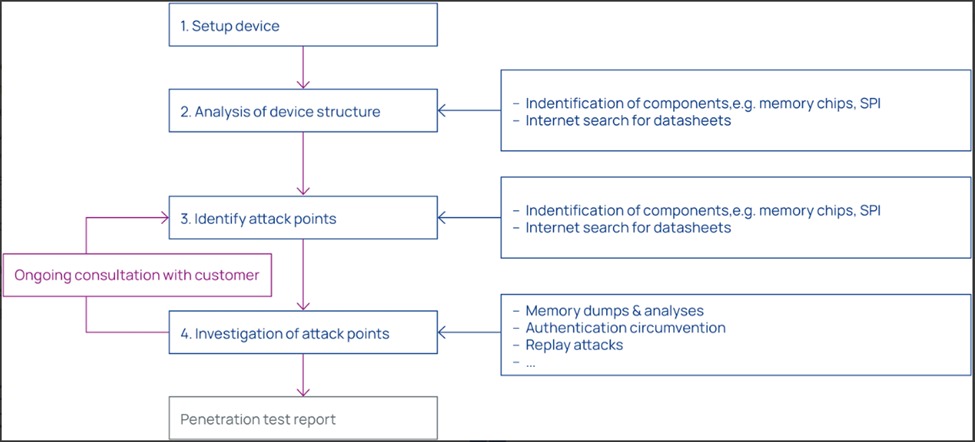Automobile penetration testing, also known as automotive penetration testing or car hacking, is a specialized form of security testing focused on identifying and addressing vulnerabilities in the electronic systems of vehicles. This process involves simulating real-world cyberattacks to assess the resilience of a vehicle's software, hardware, and communication networks against malicious actors.
During automobile penetration testing, security experts attempt to exploit potential vulnerabilities in various components of the vehicle, including its infotainment system, onboard computers, telematics systems, wireless communication modules, and other electronic control units (ECUs). These tests often involve techniques such as reverse engineering, fuzzing, and exploiting software bugs to gain unauthorized access or control over critical functions of the vehicle.
Discovering weaknesses in the vehicle's software, firmware, and network infrastructure that could be exploited by attackers.
Testing the effectiveness of security measures such as access controls, authentication mechanisms, encryption protocols, and intrusion detection systems.
Offering recommendations and guidance for mitigating identified vulnerabilities and improving the overall security posture of the vehicle.
Analyzing the entry points and potential attack vectors that adversaries could use to compromise the vehicle's security.
Providing stakeholders with concrete evidence of the potential consequences of security breaches, including impacts on safety, privacy, and vehicle functionality.
Also known as ethical hacking, penetration testing involves simulating cyberattacks to identify vulnerabilities in vehicle systems. This includes attempting to exploit weaknesses in software, hardware, or network infrastructure to gain unauthorized access or control over critical functions.
Vulnerability assessment involves scanning vehicle software and network components to identify known security vulnerabilities. Automated tools are used to search for weaknesses such as outdated software versions, misconfigurations, or insecure protocols.
Security experts review the source code of vehicle software to identify potential security flaws. This includes analyzing code for common vulnerabilities like buffer overflows, injection attacks, or insecure authentication mechanisms.
With the increasing connectivity of modern vehicles, wireless
communication testing assesses the security of protocols such as Bluetooth, WI-Fi, or cellular networks. This involves evaluating encryption protocols, authentication mechanisms, and susceptibility to interception or manipulation.
Cryptographic analysis evaluates the strength and effectiveness of encryption mechanisms used to protect sensitive data within the vehicle. This includes assessing the robustness of encryption algorithms, key management practices, and secure storage mechanisms.
Security architecture review involves evaluating the overall design and implementation of security features within the vehicle. This includes assessing access controls, secure boot mechanisms, secure update mechanisms, and other security-related components.
Privacy testing focuses on evaluating how vehicle systems handle and protect sensitive user data. This includes assessing data collection practices, consent mechanisms, anonymization techniques, and compliance with privacy regulations such as GDPR or CCPA.
Compliance testing ensures that vehicles adhere to relevant industry standards and regulations related to automotive cybersecurity. This includes standards like ISO/SAE 21434, UN Regulation No. 155, or other regional regulatory requirements.
The penetration test or pen test captures certain types of security weaknesses like unintended user action and associated architecture flaws more effectively than others. We all are aware that the penetration test is a late cycle activity with a huge resource crunch and time constraints. Therefore, we need a focused testing approach, risk-oriented grey-box penetration test solves this issue.
Grey-Box penetration test is like the black-box pen test, where the system is treated from the outside, however in this case, the tester is having the high-level architecture knowledge and carries out the pentest based on his acquired experiences and architecture specific heuristics. This makes the Grey-box pentest an intelligent security testing mechanism. We perform a systematic and through Threats Analysis and Risk Assessment (TARA) at the concept phase and utilizes the output in carrying out our novel grey-box penetration testing.
• Risk-based testing with a customized and thus efficient grey-box methodology
• Easy to understand, asset related results with a clear structure
• Prioritized list of findings based on the impact categories
All available hardware interfaces of the system will be determined,and preliminary tests will be performed to detect target responsiveness towards communication attempts over the respective external interface.
The network traffic will be analyzed to determine used protocols, communication patterns and determine the systems baseline behavior.
With the information from network discovery, we are able to mount network-based attack against the system, using low-level access to the bus to stress the DUT with forged frames.
Through reverse engineering vulnerabilities are searched and possible attack vectors determined.

Automotive penetration testing methodology involves a systematic approach to identifying and mitigating security vulnerabilities in vehicles. While specific methodologies may vary depending on the organization or security team conducting the testing, here's a generalized outline of the process:
By following a structured automotive penetration testing methodology, security teams can effectively identify and mitigate security vulnerabilities in vehicles, helping to enhance the overall cybersecurity resilience of modern automotive systems.
| S.No | Category | Tools |
|---|---|---|
| 1. | Operating System | Kali Linux, Windows, Parrot OS |
| 2. | Framework | ISO/SAE 21434, UNECE WP.29 Regulation No. 155, SAE J3061, NIST Cybersecurity Framework, Autosar |
| 3. | Scanning | Nmap, Hping, Zenmap, CANutil, SocketCAN, CANBus Triple, Kvaser CANlib SDK, CarShark, Uptane |
| 4. | Fuzzing | CANutil |
| 5. | Vulnerability Assessment | Burp Suite Pro, American Fuzzy Lop (AFL), SocketCAN, CANalyzer/CANoe |
| 6. | Exploitation | Metasploit Framework, GitHub Scripts, Sqlmap |
| 7. | Traffic Analysis | Wireshark, TCP dump |